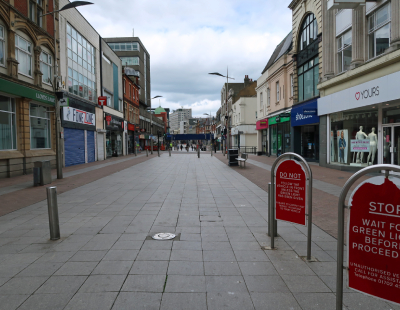This is an expected move as quantitative easing has been the monetary policy tool of choice for the last twelve years, keeping interest rates close to zero or negative, and resulting in blue chips yielding returns of 1-2% at the most.
Affordable mortgages are making housing more expensive
In this context, demand for risk-free assets generally stays steady or continues to rise. Residences are the least risky type of real estate as demand for residential housing comes from large institutional investors - such as funds or investment companies that purchase apartments by the hundreds and thousands - as well as private clients who buy property for their own use or to lease out.
House prices in most European countries are currently steady or surging, as we can see from pricing trends in the UK, Germany, the Netherlands, and Portugal. Demand is primarily underpinned by mortgage programmes that cover up to 80–90% of the apartment price at 0.5-1.5% per annum, with the rest subsidised by the state.
Developers have noticed an emerging trend that indicates a strong preference for larger homes as many shift to remote work. Buyers are now increasingly asking for homes and apartments with separate quiet rooms or fully equipped studies.
Office rentals to go back to 2017-2018 rates
Slackening business activity as a result of the Covid-19 pandemic and lockdowns has reduced demand for office spaces. As a consequence, the price of office spaces has decreased.
As yet, no one knows what the arm’s-length office rental rates will look like in the next two years, but from today’s perspective, office rents are likely to drop to 2017-2018 rates, which is 15-20% lower than the 2019 peak rates. Class C and outlying properties are expected to be the most vulnerable.
As remote work is likely to continue through 2021, companies will prefer renting smaller office spaces. At the same time, 2021 might be the best time to invest in such properties as they will be available to purchase at reasonable prices. These are bargains to jump at, more so because of how overheated the market was in 2019 and early 2020.
Sell-offs or material discounts are not to be expected for quality properties in central locations, but it would be possible to find a challenging complex redevelopment project at a stone’s throw from the centre that might be a bit outworn and/or has bad tenants. Investing in such properties could result in interesting potential capitalisation growth when economic activity revives.
The future of retail is obscure
Most retail spaces and restaurants are losing ground this pandemic. According to Opentable, the average restaurant occupancy rate in 2020 declined by 35% compared to 2019 levels in Germany, and by 50% in the UK.
European governments are struggling to support businesses by channelling money to cover lost profits and partial payrolls, and granting interest-free loans. Many tenants are renegotiating their rental rates.
While there has been no sign of mass bankruptcies so far, some private owners and large chains have indeed gone bankrupt. For example, US-based clothing retailer Brooks Brothers, Italian restaurant chain Vapiano, and German restaurant chain Maredo have all filed for bankruptcy in 2020.
While big supermarkets and shops in residential districts have been less affected by the pandemic, other retail spaces are unlikely to go back to 2019-level returns in the near future. Even as e-commerce is booming, retail spaces occupied by non-food FMCG companies are facing many challenges.
That said, great challenges often imply great opportunities. Many investors and developers are now considering the redevelopment of malls for different purposes - residential housing, or walkable storage spaces, to name a few. Such properties are often located in the centre of the city, so they are unlikely to stay unoccupied for long. For example, John Lewis, a UK-based chain of department stores, has decided to take up the construction of rental homes in the areas near their retail properties.
Private clients might be interested in small retail spaces in pedestrian precincts that could be available at a discount. However, such properties are more likely to be sold without tenants and would not be subject to leveraged acquisition.
Hotels first in line to take lockdown hit
In the spring of 2020, governments supported hoteliers by offering payroll subsidies, rent-free periods, and other financial aid. When some lockdown measures were lifted in the summer, hotels saw an organic accretion of occupancy rates, albeit far from returning to pre-pandemic numbers.
The average occupancy rate at German hotels plunged from about 80% in 2019 to 30-40% in the summer of 2020, even before the second wave of Covid-19 cases. Amid the second wave of Covid-19 cases in the autumn, hoteliers lost about 70% of their returns for the season, including revenue usually generated by MICE tourism.
Judging by the most recent Covid-19 case statistics, there is little chance of restrictions lifting soon. This means hotels are unlikely to see occupancies bounce back until at least the summer of 2021. To make things worse, even the autumn of 2021 remains doubtful. This could result in up to a third of hotel projects going bankrupt in the coming quarters.
If we assume that tourist and business traffic will be restored now that a few effective vaccines are being rolled out, then today is a better time than in the past decade to invest in the hotel segment.
I believe that central properties in developed countries like Germany will be sold at minimum discounts as the market is awash in money. That is why we at Tranio expect to buy something in B and C segment locations. We saw some bargain deals in early December 2020, but they were discounted at 10-20% of 2019 prices, depending on the property’s location and quality.
In a joint effort with our partners, we are actively looking at opportunities in Italy and Spain where pledge-holding banks are not as confident as their German peers. We are already considering bank proposals in central Rome and Milan for sale at a discount of about 30% of the 2019 price.
Burgeoning demand for microapartments in mid- and long-term rental sector
A shared living niche in the market that has been growing briskly over the last decade comprises microapartments, co-living arrangements, and student apartments.
These can be split into two formats: short-term/daily rent and mid-term/monthly (or longer) rent.
Daily rental arrangements have been affected most profoundly by the Covid-19 pandemic as occupancies have been low. Most such properties will shift to mid-term and long-term rental offers in the future, whereas hotels will tilt towards the apartment hotel format.
A studio room that features a kitchen could be a self-contained unit in an apartment hotel. This could substitute a fully-fledged home and would make apartment hotels more attractive, mitigating the risk of underperformance due to low occupancy rates.
Demand for small apartment leases in the residential districts of large and mid-sized cities is unlikely to subside, ensuring such projects remain of interest to investors. However, the boarding house segment, which targets business travellers, is in distress.
Banks are reluctant to finance such projects as there is uncertainty about whether their corporate clients will pay up for potential travel costs in the next two years.
Rising prospects for investment in senior living facilities
In the midst of the market turbulence that has hit classic types of commercial real estate, new yet promising asset classes like senior living facilities are keeping the market afloat.
Rental income for this segment has remained steady despite the Covid-19 crisis as the occupancy rates for these facilities do not decline and the tenants are either affluent enough to make timely rent payments, or the government subsidises their rent.
Senior housing in Europe yields returns of 4-5% on average. The prospects are rather optimistic as Europe’s population is ageing and demand for senior living facilities will be going up in the coming decades. Indeed, there are already queues for senior care facilities at many locations in Germany.
Hybrid lease contracts to gain popularity
The Covid-19 pandemic has shown that fixed lease arrangements do not protect leaseholders in many countries. For this reason, I expect the market to move towards management agreements and hybrid contracts instead.
A hybrid contract brings together the features of a lease contract and a management agreement, and is determined by the minimum rent payment plus a percentage of the tenant's revenue or profit.
At the same time, fixed lease agreements will remain attractive for a long time, particularly to banks, institutional buyers and owners who do not want to delve into the finer details of their tenants’ businesses. Nonetheless, owners will be forced to better understand their tenants’ businesses in the future, in order to assess the inherent risks of investing in a particular property.
Developers to bet on housing, senior living facilities, and warehouses
Countries in southern Europe have lower capital liquidity, poorer banks, and have seen less government support and subsidies for businesses. For these reasons, southern Europe is expected to experience more bankruptcies, property seizures, and sell-offs at lower prices.
By contrast, well-off countries in northern Europe are likely to rebound quicker, even in those real estate segments where yields have dropped notably.
Declining personal incomes, reduced passenger traffic, and restricted opportunities to move and travel have hit the hospitality sector hard. However, the essential needs of people remain the same, so housing today looks as if it could not be better. People are going to restaurants and cafés less and buying more at shops, giving a boost to online shopping or e-tailing and storage facilities.
Developers are now building homes, senior care facilities, and warehouses more actively than other segments. Offices, hotels, and retail spaces are reeling from deterioration in their tenants’ businesses and their liquidity is decreasing accordingly.
*George Kachmazov is managing partner at international real estate broker Tranio








.png)










Join the conversation
Be the first to comment (please use the comment box below)
Please login to comment